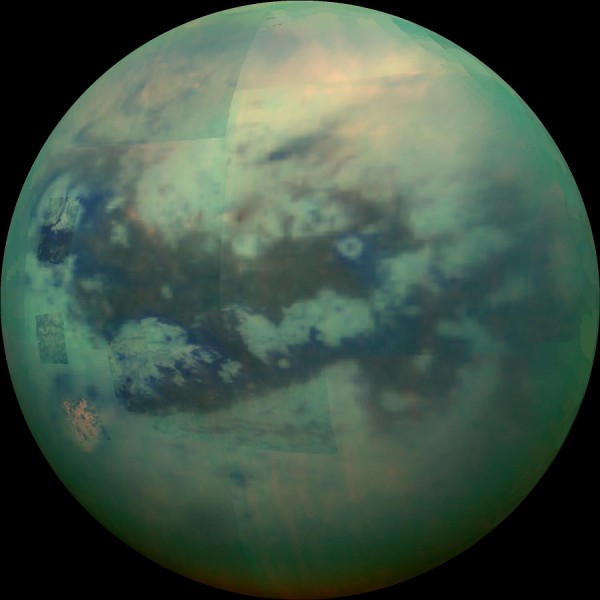By Ana Verayo, | March 20, 2017

This composite image shows an infrared view of Saturn's moon Titan from NASA's Cassini spacecraft. (NASA/JPL/University of Arizona/University of Idaho)
NASA's Cassini spacecraft just revealed that Saturn's largest moon, Titan, possesses a surface that is apparently so bubbly and fizzy. Mission scientists at NASA's Jet Propulsion Laboratory simulated Titan's environment and found out that its lakes and seas are like literally a can of soda shaken up.
Like Us on Facebook
Water can absorb gases depending on pressure and temperature such as carbon dioxide, oxygen and nitrogen. However, water exposed to higher pressures and extremely freezing temperatures can absorb more carbon dioxide and lesser carbon dioxide vice versa. This is the reason why warm soda goes flat immediately.
Mission scientists say that Titan is apparently something similar to a can of soda, but this moon hosts nitrogen and a cocktail of cryogenic liquids. Surface temperatures can reach negative 291 degrees Fahrenheit, where the atmosphere is made of 95 percent nitrogen and the rest is methane.
These fizzy lakes and seas are a mixture of hydrocarbons that are mostly made of rainfall of methane and ethane. However, during Cassini flybys of Titan, the spacecraft detected that these cryogenic liquids can change in composition and even alter its properties, that can change their ability to absorb or release nitrogen.
Inside laboratory conditions, researchers compared this nitrogen solubility found in Titan's seas and compared this by creating artificial lakes to mimic Titan's. Researchers then exposed these different mixtures of methane and ethane to pressures and temperatures detected on Titan. These observations provided important clues about the seas and lakes on Titan and how these mixtures behaved and absorbed nitrogen.
More specifically, Titan's lakes and seas are now highly unstable because of this, making them more sensitive to such environmental changes. For example, a slight temperature increase or shift in methane-ethane ratio from heavy rainfall can cause the nitrogen to bubble our or fizz out.
When these lakes and oceans on Titan freeze, the ethane becomes dense and sinks at the bottom. The methane-ethane ration changes again and this causes lakes to bubble, releasing nitrogen. Extreme temperatures can apparently make lakes and seas on the moon to bubble, basically.
This new study is published in the journal, Icarus.
-
Use of Coronavirus Pandemic Drones Raises Privacy Concerns: Drones Spread Fear, Local Officials Say

-
Coronavirus Hampers The Delivery Of Lockheed Martin F-35 Stealth Fighters For 2020

-
Instagram Speeds Up Plans to Add Account Memorialization Feature Due to COVID-19 Deaths

-
NASA: Perseverance Plans to Bring 'Mars Rock' to Earth in 2031

-
600 Dead And 3,000 In The Hospital as Iranians Believed Drinking High-Concentrations of Alcohol Can Cure The Coronavirus

-
600 Dead And 3,000 In The Hospital as Iranians Believed Drinking High-Concentrations of Alcohol Can Cure The Coronavirus

-
COVID-19: Doctors, Nurses Use Virtual Reality to Learn New Skills in Treating Coronavirus Patients







